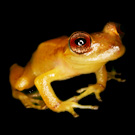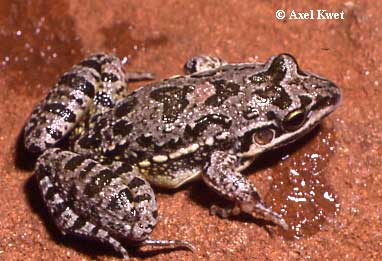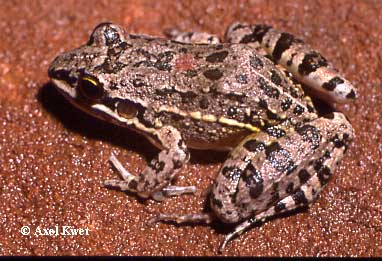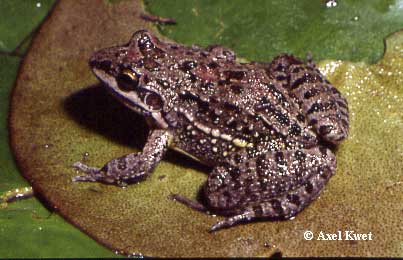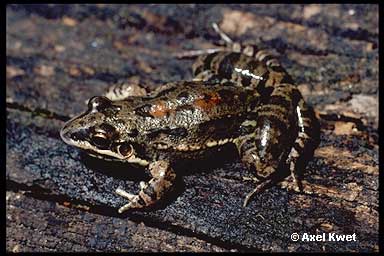

|
 |
 |
 |
 |
 |
 |
 |
 |  |
 |
 |
Merkmale |
Gesamtlänge 30-40 mm. Schnauze spitz. Rücken grau bis gelblichbraun mit wenigen schwarzen Flecken und zwei hellen Längsdrüsenleisten sowie einem rötlichen Rückenfleck. Zwischen den Augen ein Paar schwarzer Interokularflecken. Bauch weiß, ungefleckt. |
 |
 |  |  |
 |
 |
Verbreitung |
Südbrasilien, Nordostargentinien und Uruguay. |
 |
 |  |  |
 |
 |
Lebensraum |
Offenland, an Temporärgewässern. |
 |
 |  |  |
 |
 |
Biologie |
Das Gelege wird in der Nähe von Gewässern innerhalb selbst gebauter, unterirdischer Kammern in Form eines Schaumnestes abgelegt. Die Larven werden durch Überflutung frei. |
 |
 |  |  |
 |
 |
Literatur |
Achaval, F. & A. Olmos (2003): Anfibios y reptiles del Uruguay. 2. edition. - Montevideo, Uruguay (Graphis Impresora), 136 pp.
Basso, N. G. and G. J. Basso (1985). Aspectos bioacústicos del canto nupcial de Leptodactylus latinasus (Anura: Leptodactylidae). Acta zool. lilloana 41: 121-124.
Basso, N. G. and A. I. Kehr (1991). Postmetamorphic growth and population structure of the frog Leptodactylus latinasus (Anura: Leptodactylidae). Stud. Neotrop. Fauna Environment 26(1): 39-44.
Cei, J.M. (1980): Amphibians of Argentina.- Monitore zool. ital. (N.S.), Monogr. 2: 1-609.
Fernandez, K. and F. Fernandez (1921). Sobre la biologia y reproducción de algunos batracios argentinos. I. Cystignathidae. An. Soc. Cient. Arg. 91: 97-140.
Gallardo, J. M. (1958). Observaciones biológicas sobre Leptodactylus prognathus Boulenger. Ciencia e Investigación 14(10/11): 460-465.
Langone, J.A. (1994): Ranas y sapos del Uruguay (Reconocimiento y aspectos biológicos). - Museo D. A. Larraņaga, Montevideo, Serie de Divulgación, 5: 1-123. |
 |
 |
|
